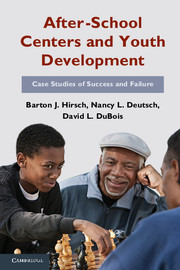Book contents
- Frontmatter
- Contents
- Figure and Tables
- Preface
- Introduction
- Midwest Center
- 2 Pockets of Excellence
- 3 Pocahontas Joins the Tribe
- 4 Bill: The Pros and Cons of Being One of the Guys
- 5 Putting It All Together: Midwest Center
- North River Center
- West River Center
- Conclusion
- Appendix Data Sources
- References
- Index
2 - Pockets of Excellence
Published online by Cambridge University Press: 05 June 2012
- Frontmatter
- Contents
- Figure and Tables
- Preface
- Introduction
- Midwest Center
- 2 Pockets of Excellence
- 3 Pocahontas Joins the Tribe
- 4 Bill: The Pros and Cons of Being One of the Guys
- 5 Putting It All Together: Midwest Center
- North River Center
- West River Center
- Conclusion
- Appendix Data Sources
- References
- Index
Summary
The Midwest after-school center occupies a building that housed a bank for many years. It is the smallest of the three clubs, particularly in the size of the gym. The former bank lobby, which has been converted to a gym, has less space and lower ceilings than gyms in the other clubs. The center is located in a community that used to be predominantly Latino, but has recently witnessed the arrival of increasing numbers of African American families. As is true of the neighborhoods near all of the centers we studied, there are a number of gangs in the area. Violence and drugs are major concerns. The crime rate in the area surrounding Midwest is higher than that found in 90 percent of neighborhoods in the city.
Our initial survey questionnaire provides a good sense of those youth who came to the center who were at least ten years old. The survey was completed by 62 youth ages 10–16, with a mean (average) age of 12.16 (of the clubs we studied, Midwest has the fewest youth). The sample was 66 percent Hispanic, 34 percent African American, 8 percent white, and 2 percent Asian American (figures sum to more than 100%, as some youth checked more than one box). It was a high-poverty sample, as 83 percent reported receiving free or reduced-price lunch. It was also a high-attendance sample, as most of the young people had been coming to Midwest for several years and came almost every weekday for at least two to four hours daily. At the beginning of the year, there were five full-time and two part-time staff (which includes a full-time administrator); by the end of the year, two additional full-time staff had joined the center.
- Type
- Chapter
- Information
- After-School Centers and Youth DevelopmentCase Studies of Success and Failure, pp. 33 - 62Publisher: Cambridge University PressPrint publication year: 2011

